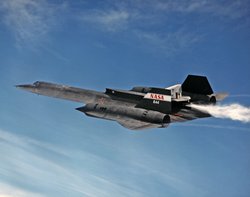Dryden Flight Research Center
|
|
DFRC_fleet.jpg
NASA's Dryden Flight Research Center, located inside Edwards Air Force Base, was named in honor of the late Hugh L. Dryden, one of America's most prominent aeronautical engineers, on Mar. 26, 1976. At the time of his death in 1965, he was NASA's deputy administrator. First known as the National Advisory Committee for Aeronautics Muroc Flight Test Unit, the DFRC has also been known as the High-Speed Flight Research Station (1949) and the High-Speed Flight Station (1954).
The Center is NASA's premier site for aeronautical research and operates some of the most advanced aircraft in the world.
Until 2004, Dryden operated the oldest B-52 Stratofortress bomber, a B-52B model which had been converted to drop test aircraft. It dropped a large number of supersonic test vehicles, ranging from the X-15 to Pegasus rocket boosters. It was also the last B-52B still flying, but had the fewest flight hours of any existing B-52 bomber. The aircraft was retired when the last X-43A test flight occurred, and was replaced by a newer B-52H model.
| Contents |
Douglas Skyrocket
Douglas_Skyrocket_being_dropped.jpg
Main article: Douglas Skyrocket
NASA's predecessor, NACA, operated the Douglas Skyrocket. A successor to the Air Force's Bell X-1, the D-558-II could operate under rocket or jet power. It conducted extensive tests into aircraft stability in the transsonic range, optimal supersonic wing configurations, rocket plume effects, and high-speed flight dynamics. On November 20, 1953, the Douglas Skyrocket became the first aircraft to fly at over twice the speed of sound when it attained a speed of Mach 2.005. Like the X-1, the D-558-II could be air launched, but it used a Navy B-29 instead of a B-52. Unlike the X-1, the Skyrocket could also takeoff from a runway with the help of JATO units.
Controlled Impact Demonstration
CID_closeup_1.jpg
Main article: Controlled Impact Demonstration
The Controlled Impact Demonstration was a joint project with the Federal Aviation Administration to research a new jet fuel that would decrease the damage due to fire in the crash of a large airliner. A remotely piloted Boeing 720 aircraft was flown into specially built wing openers which tore the wings open and fuel sprayed everywhere. Despite the new fuel additive the resulting fire ball was huge and the fire still took an hour to fully extinguish.
Even though the fuel additive did not prevent a fire the research was not a complete failure. The additive still prevented the combustion of some fuel which flowed over the fuselage of the air craft and served to cool it similar to how a conventional rocket engine cools its nozzle. Also instrumented crash test dummys were in the airplane for the impact and provided valuable research into other aspects of crash survivability for the occupants.
Linear Aerospike SR-71 Experiment
Main article: LASRE
LASRE was a NASA experiment in cooperation with Lockheed Martin to study a reusable launch vehicle design based on a linear aerospike rocket engine. The experiment's goal was to provide in-flight data to help Lockheed Martin validate the computational predictive tools they developed to design the craft. LASRE was a small, half-span model of a lifting body with eight thrust cells of an aerospike engine. The experiment, mounted on the back of an SR-71 Blackbird aircraft, operated like a kind of "flying wind tunnel."
The experiment focused on determining how a reusable launch vehicle's engine plume would affect the aerodynamics of its lifting body shape at specific altitudes and speeds reaching approximately 750 miles per hour (335 meters per second). The interaction of the aerodynamic flow with the engine plume could create drag; design refinements look to minimize that interaction.
Lunar Landing Research Vehicle
LLRV_2.jpg
Main article: Lunar Landing Research Vehicle
The Lunar Landing Research Vehicle or LLRV was an Apollo Project era program to build a simulator for the Moon landing. The LLRVs, humorously referred to as flying bedsteads (see also Flying bedstead), were used by the FRC, now known as the NASA Dryden Flight Research Center, at Edwards Air Force Base, Calif., to study and analyze piloting techniques needed to fly and land the Apollo Lunar Module in the moon's airless environment.
Jfader_dryden.jpg
External links
- NASA Dryden Flight Research Center web site (http://www.dfrc.nasa.gov)de:Dryden Flight Research Center

